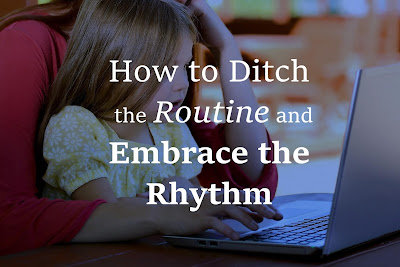How to Ditch the Routine and Embrace Daily Rhythm
How to Ditch the Routine and Embrace Daily Rhythm
In our American culture, we live and die by the clock. We go from one appointment or task to the next. For many of us, much of what we do fits neatly into a time slot on the calendar (or, more realistically, we try to fit five tasks into one slot).Our routines and schedules have been turned upside down by COVID-19. Some of us miss the tasks that once filled our days. This can provoke feelings of both relief and unsettledness. Others find their to-do lists doubled and in ways that are unfamiliar to them. Many working parents that have not felt the call towards homeschooling are now CEOs and teachers simultaneously. I have received your calls and texts and have seen your social media posts about trying to balance the two.
You are tired. You are overwhelmed. You are stressed. I see you.
No doubt, there needs to be some sense of order in your home. If not, it will be cookies for all the meals and the ceiling fan will become a newfound merry-go-round. You need your house to be intact! How would your life change if you implemented rhythms instead of routines during this time? It is definitely a mind shift from our traditional ways of doing things, but keeping it real, how is traditional working for you right now? Do you have peace? Are you overwhelmed with trying to fit all the things on the calendar? How is this even done?
To embrace a life of rhythms vs schedule during this time, I suggest the following:
- Determine Must Do’s For The Day. If your family is accustomed to having three meals a day, then make that a priority. If storytime with the kids is a priority, then make sure that is done each day. This can be a wonderful opportunity to assess what is truly important each day. Not all the things need to happen.
- Create a list of things that needs to be done weekly. Focus on the week, and not necessarily the day. These things will go in between the must do’s for the day. What doesn't get done today goes to the top of the list for tomorrow. This takes away the pressure of having to do all the things each day, and trying to force life into time slots.
Why Should I Incorporate Rhythms
- It allows your family to move at a comfortable pace. All of America has been thrown into a state of disorganization. We are all trying to find our balance. It is unreasonable to assume that one schedule is going to work for every family and for all family members.. Establishing a rhythm in your family will help allow the specific needs of your family to be met.
- It will help give you grace and peace. I am becoming more convinced that the standard way of American life, long before COVID-19 ever came on the scene, was unhealthy. We are overworked. We are stressed and exhausted. We try to fit everything into time slots at the expense of physical and emotional rest. When this is our norm, and now our workload has doubled by homeschooling, is it any surprise so many of us are on the struggle bus? By implementing rhythms in our daily life rather than strict schedules, we create a space for Plan Bs to happen without losing our minds. We cultivate peace by releasing the pressure of the clock.
I encourage you to begin thinking of your days in terms of rhythms instead of schedules. And for those of you who don't have kids, this concept still applies. Set aside time for work and responsibilities. Determine what has to happen today, but find moments to keep running lists and incorporate them around the must-dos. You might even learn in the process that your must-do’s were not as crucial as you thought. Embrace the opportunity for rest that inevitably comes with rhythms, and claim peace for yourself in a time where chaos seems to surround you.
 |
Authored by: Rachel Nauss, LCSW
Rachel is passionate about all aspects of health and wellness and believes in a holistic approach when considering mental health. Rachel obtained a Masters in Social Work from the University of Texas at Arlington in 2006 and is a Licensed Clinical Social Worker.
Rachel is a child and adult therapist at The Hope Place and is currently offering online sessions for children, adolescents, and adults.

Comments
Post a Comment